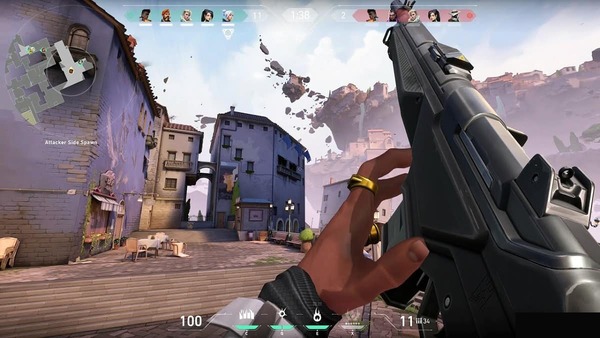Understanding Smurfing: What It Is and Why It Happens 
Smurfing is when a skilled player uses a secondary account—often unranked or low-ranked—to play against players of lesser skill. This gives the smurf an overwhelming advantage and severely disrupts matchmaking balance.
There are several reasons why players smurf in Valorant. Some want to play with lower-ranked friends, others seek to escape the stress of competitive play on their main accounts. A few use smurfs to practice new agents or strategies without risking their rank. Still, many smurf simply to dominate and enjoy the feeling of outclassing opponents, a behavior that undermines the very foundation of fair play.
The Early Days: Smurfing in Valorant's Beta and Year One
In Valorant's beta phase and early months after release, Riot was still developing its ranking system and anti-cheat infrastructure. The lack of strict account verification made it easy for players to create smurfs. Ranked queues quickly filled with experienced players stomping beginners.
At the time, Riot had limited tools to prevent or even detect smurfing. Many popular streamers and influencers smurfed openly for content, glorifying the behavior and encouraging viewers to do the same. This normalized smurfing and blurred the line between casual fun and competitive exploitation.
Smurfing's Effect on New Player Experience
For new players, smurfing is a nightmare. Instead of learning the game at a manageable pace, they face opponents who consistently out-aim, out-position, and out-strategize them. These demoralizing matches cause many to quit before ever reaching a fair skill level.
This has a ripple effect. Riot’s matchmaking system collects data from early matches to assign an initial rank. If smurfs destroy new players in those games, the algorithm misjudges real skill, placing players too low or too high in the ladder. It distorts the learning curve and turns onboarding into a frustrating ordeal.
Ranked Integrity: A System Under Siege
Smurfing causes inflation and distortion in Valorant's ranking system. Skilled players dominate lower tiers on alternate accounts, pushing average-skilled players down artificially. This misdistribution erodes confidence in matchmaking and rank progression.
When matches are consistently decided by the presence or absence of a smurf, trust in the competitive system collapses. Players may abandon ranked play entirely or resort to smurfing themselves to avoid unfair matchups, creating a vicious cycle.
Psychological Impact on Players
The presence of smurfs creates more than just statistical imbalance—it impacts player morale. Consistently losing to far better players can lead to self-doubt, frustration, and in extreme cases, burnout.
Toxicity also rises in smurf-heavy lobbies. Players begin to accuse each other of smurfing or throwing, further damaging team cohesion. The sense of camaraderie and fairness that competitive games rely on is quickly replaced with suspicion and resentment.
Riot’s Initial Responses: Detection and Penalties
Riot eventually acknowledged the smurfing problem and began working on detection algorithms. These systems analyzed player behavior, kill-death ratios, and performance metrics to identify accounts performing far above their supposed skill level.
Detected smurfs could be placed under review, restricted from ranked, or forced into faster rank calibration. Riot also began banning accounts linked to excessive disruptive behavior. Still, these measures were limited in scale and effectiveness, especially with new smurfs being created daily.
Smurf Queue: A Temporary Fix?
In 2023, Riot introduced a controversial measure known informally as the "smurf queue." This system would match flagged accounts—those performing significantly above average—with other suspected smurfs.
This approach was meant to isolate smurfs from the general population, providing more accurate data and minimizing damage to normal players. However, the community’s reaction was mixed. Some praised the idea, while others criticized it as vague, slow, and easy to bypass by playing inconsistently.
Third-Party Smurfing Services and Account Selling
As the game grew, third-party markets began selling Valorant accounts. These ranged from unranked accounts to ones with Gold, Platinum, or even Immortal rankings. The proliferation of these services fueled the smurfing epidemic.
In response, Riot targeted these sellers through legal and technical means, issuing bans and working with cybersecurity teams to trace IP patterns and fraudulent activity. Despite these efforts, the sheer scale and anonymity of the internet make it extremely difficult to eliminate the practice entirely.
Community Reactions and Grassroots Initiatives
Valorant's community has grown increasingly vocal about smurfing. Popular content creators have taken public stances against the behavior, with some refusing to use alt accounts. Others encourage reporting suspected smurfs and call for stronger in-game systems.
On social media and platforms like Reddit and Discord, community-led initiatives aim to track smurfs, compile reports, and spread awareness. However, this sometimes leads to false accusations and harassment, further complicating the issue. Nonetheless, it signals a growing desire for accountability and reform.
The Future: What Needs to Be Done?
To truly curb smurfing, Riot must rethink its approach. Stronger account verification—such as mandatory phone linking or hardware ID restrictions—could deter casual smurfing. Rewards for consistent play on main accounts could incentivize loyalty.
Changes to ranked progression could also help. If the system focused more on long-term performance and team impact rather than short-term wins and losses, the pressure to maintain perfect records would lessen, and fewer players would feel the need to smurf.
Equally important is shifting the culture. Competitive gaming must emphasize integrity over dominance. Riot, content creators, and community leaders must continue to promote fairness, cooperation, and responsible gameplay.
Conclusion: Preserving Valorant’s Competitive Spirit
Smurfing in Valorant is more than just a nuisance—it’s a systemic threat to fair play and competitive integrity. While Riot has made progress with detection systems and community outreach, much work remains. The road forward lies in technical innovation, smarter matchmaking, stronger deterrents, and a collective effort from the entire community.
If Riot wants Valorant to remain a competitive cornerstone in esports and casual gaming alike, it must treat smurfing not as a minor annoyance, but as a central design and policy challenge. Only through consistent, coordinated efforts can the game truly deliver on its promise of fair and balanced competition.
 Roblox Grow a Garden
Read full review
Roblox Grow a Garden
Read full review
 Avatar World
Avatar World is an imaginative sandbox simulation game where players can create and customize unique avatars, explore diverse interactive environments, and craft their own stories through roleplay. With vibrant graphics, a wide range of locations (like schools, hospitals, beaches, and space stations), and a rich selection of clothes, pets, and props, Avatar World offers endless creativity for kids and teens.
Read full review
Avatar World
Avatar World is an imaginative sandbox simulation game where players can create and customize unique avatars, explore diverse interactive environments, and craft their own stories through roleplay. With vibrant graphics, a wide range of locations (like schools, hospitals, beaches, and space stations), and a rich selection of clothes, pets, and props, Avatar World offers endless creativity for kids and teens.
Read full review
 Gacha Club
Read full review
Gacha Club
Read full review
 Brawl Stars
Brawl Stars, developed by Supercell, is a wildly popular multiplayer mobile game that delivers fast-paced, action-packed gameplay in a colorful and competitive arena.
Read full review
Brawl Stars
Brawl Stars, developed by Supercell, is a wildly popular multiplayer mobile game that delivers fast-paced, action-packed gameplay in a colorful and competitive arena.
Read full review
 Delta Force
Delta Force is a name that resonates deeply with fans of military tactical shooters. Launched during a time when first-person shooters were just starting to evolve beyond the fast-paced arena style
Read full review
Delta Force
Delta Force is a name that resonates deeply with fans of military tactical shooters. Launched during a time when first-person shooters were just starting to evolve beyond the fast-paced arena style
Read full review
 Grand Theft Auto VI
GTA VI redefines open-world gaming with advanced features, including realistic insurance and claim systems in both story and online modes
Read full review
Grand Theft Auto VI
GTA VI redefines open-world gaming with advanced features, including realistic insurance and claim systems in both story and online modes
Read full review






















